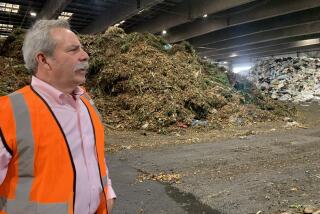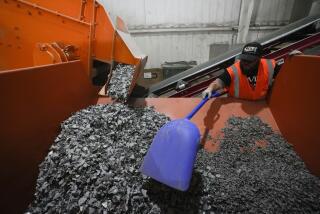Teach a Junkyard Dog to Byte and He Learns Some New Tricks
- Share via
There’s no doubt that Jim Gaye runs an auto-wrecking yard. Pneumatic tools chatter and roar as workers strip parts from crumpled cars on the 2 1/2-acre lot in an industrial neighborhood near Orange County’s civic center.
But look beyond the stacks of used wheels and racks of salvaged parts in the drafty front office and you’re likely to see a grizzled yardman tapping an inquiry into one of several computers lining the front counter at Gaye’s Wrecks West.
Within seconds, the computer tracks down the item from the yard’s inventory of almost 2 million foreign car parts stored on rows of indoor racks.
There are about 1,300 places like Wrecks West in California, and many still have tumbledown tin sheds for offices, rows of rusted hulks out back and junkyard dogs that prowl at night.
But most have long since abandoned greasy card files and raspy intercom systems in favor of sophisticated computer programs that enable them to track down anything from the taillight of a 1983 Ford F-10 to a rust-free front fender for a 1996 Ferrari.
Recently, more auto dismantlers have been signing on to the Internet, posting Web pages and launching electronic parts-finding services as a means of securing a larger chunk of the $5-billion-a-year auto-recycling business.
As the price of auto parts has climbed and insurance companies’ demand for lower repair bills intensified, auto wreckers have become mainstream sources of parts and electrical equipment for body shops, restorers and do-it-yourself mechanics who don’t want to pay top dollar for new items.
The retail price of a new engine-management computer for a late-model BMW, for instance, is $900. But David Aase strips them out of crunched Beemers at his wrecking yard in Anaheim and sells them for $125.
Computer networks have become even more important because the industry has become so much more sophisticated. Cars now have thousands of parts, and most wrecking yards have become boutiques that specialize in just a few makes or models. Few have the space to keep on hand a complete lineup of mechanical and body parts for all domestic and import cars, so they turn to computerized networks to quickly locate items they don’t have.
In the old days, when the detested appellation “junkyard” was an accurate description of most dismantling businesses, owners kept their inventories in their heads. When a customer came in and asked for something, an employee in oil-stained coveralls was dispatched to hunt it down in the back lot usually separating it from a mangled car with the help of a hefty wrench or hacksaw.
Customers usually paid cash, and old-time yard owners freely admit that a lot of the money never made it onto the books.
“That’s one reason some of us resisted computerizing for so long,” said auto recycler Hurshel Clark. “We didn’t like the idea of everything in our inventory being available to the competition and every [sales] ticket we wrote being recorded.”
But Clark broke down and installed a computer system at his Placentia yard four years ago. It took months of mind-numbing work to log all of the parts, he said, but once the system was up and running “it made a world of difference. It makes running things easier and makes this a more efficient business.”
The car-dismantling process has become more sophisticated as well, as wrecking yards try to wring every dollar from mangled hulks.
Yard operators spend thousands of dollars to buy wrecks at insurance salvage auctions and from private parties. To turn a profit, they must salvage everything they can and turn over their inventories as quickly as possible. The days of keeping stacks of wrecked cars--retrieving parts when needed--are long gone except in some rural regions.
Many auto wreckers now do their dismantling inside. Fluids and refrigerants that once were simply drained into the soil are now captured and resold. Wrecked cars seldom remain on the premises more than a few days before being reduced to a neat stack of usable, marketable parts.
In an eloquent display of recycling, the remnants are then shipped off to scrap metal yards, where they are shredded and often exported to Asian steel mills to become the raw material for a new crop of cars.
The salvaged parts--separated, cleaned and logged into computer databases--are stored on racks. Modern operations such as Lakenor Auto & Truck Salvage in Santa Fe Springs often display refurbished used parts in brightly lighted showrooms that rival those of big retail auto parts chains.
Lakenor owner Herb Lieberman said terms like “wrecking yard” don’t apply any more because wrecking a car is the last thing he wants to do. He hires technicians who take up to half a day to carefully dismantle each wreck in order to preserve as many parts as possible.
This transformation has been spurred by competitive pressure from overseas parts rebuilders, the huge demand for used parts in the collision-repair business and increasing environmental regulation. But computer technology is allowing those who remain in the business to manage and channel the changes.
Clark, who has owned Clark’s Auto Wrecking for 26 years, said he plans to put his yard on the Internet. “If you’re not up-to-date with technology in this business today, you won’t survive.”
He said dismantlers used to be able to make money just from buying wrecks and selling them to scrap yards for the value of the metal. Anything they got from parts was pure gravy.
“But now I’m lucky if I can get $25 a car from a scrap dealer,” he said of the wrecks he buys at auction for anywhere from $100 to $5,000 apiece. “The only way to make money now is to sell the parts.”
Clark’s Auto is one of about 3,000 wrecking yards in the country that have systems linked by computer, satellite and fax to a network of suppliers who take credit cards and ship by overnight delivery.
There are a number of regional and national systems for finding parts. The largest, connecting about 2,000 wrecking yards, is run by Minnesota-based ADP Parts Services, a unit of information technology giant Automated Data Processing Inc. of New Jersey. Members of the ADP network log about 8 million parts in and out of their yards each week, said Mark Herman, the company’s senior vice president.
“The computerized inventory makes it possible to run this business,” said Wrecks West owner Gaye. “My computer tells me what cars a part will fit, what it cost me and how long I’ve had it. If it’s sitting for more than a few weeks, I know that I’ve either got it priced too high or that there’s no market for it.”
Gaye, who buys an average of 10 cars a week for his Santa Ana yard, takes a laptop computer when he goes to salvage auctions. The machine is programmed to check his inventory and pricing history and tell Gaye just how much he can afford to bid on a given car to make a profit.
If he receives an order for a part he doesn’t have, Gaye or one of his employees types in an inquiry. The system automatically scans the inventories of all the other yards in the network and identifies the yards that have what he needs. Gaye can then call or e-mail the other yards to inquire about prices and place an order.
For many yards, especially in urban areas such as Southern California where crashes are frequent and at-home repairs have pretty much died out, wholesale orders from insurers and body shops have largely replaced retail sales to mechanics and do-it-yourselfers. Many Southland wreckers say as much as 80% of their business is wholesale now--double what it was five years ago when the computerized parts networks were started.
In addition, a few hundred wreckers have established home pages on the World Wide Web, and most weren’t there a year ago.
“It is still experimental, but we think it will really be beneficial,” said Penny White, co-owner of one of the country’s newest wrecking yards, 4-month-old All American Auto Parts in Indianapolis. At Aase Bros., the Porsche, Mercedes and BMW specialist, nearly 5,500 people have visited a Web page that features a color photo tour of the yard and another that shows off the museum-quality display of restored classic sports and racing cars that takes up half the front office.
Doris Aase, who designed the page, said the company pays an Internet service provider $25 a month to maintain the site and provide e-mail access for customers who order by computer--now about 20% of Aase’s business.
“It’s really been good for us,” said her husband, Dave. “As the recession went on here, there were countries overseas where the economies were healthy--and when you’re on the Internet, the whole world is your market.”






